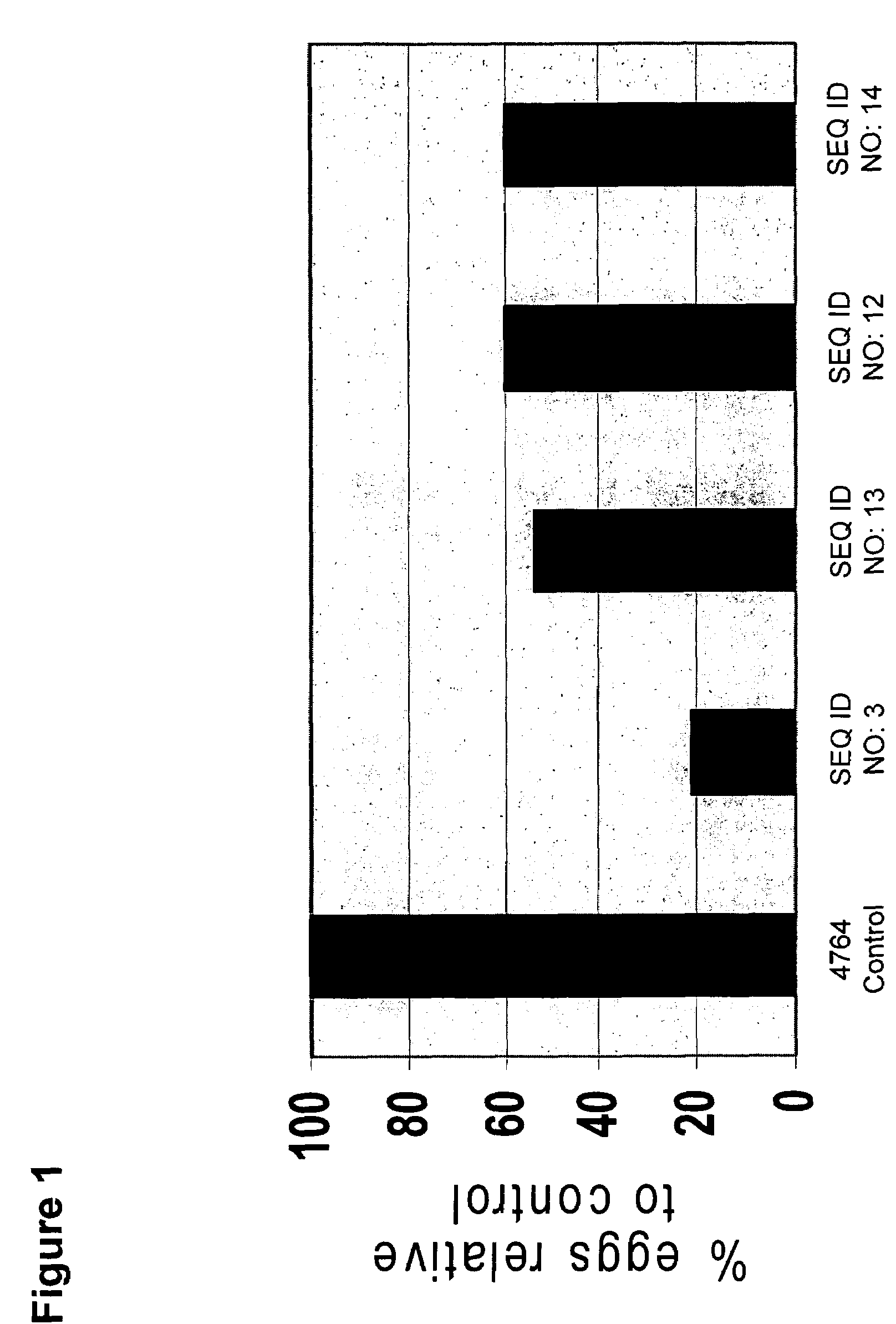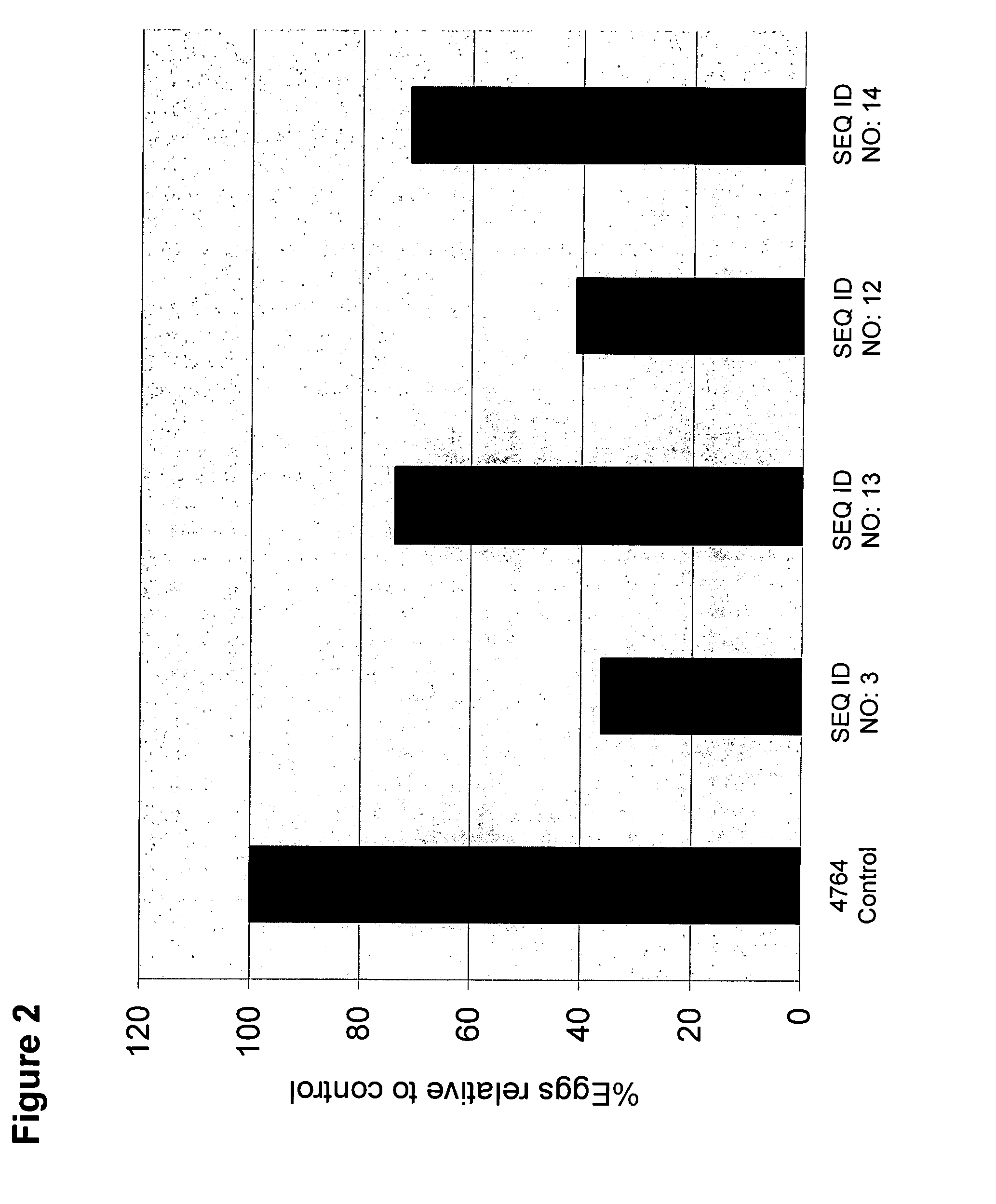Methods of protecting plants from pathogenic fungi and nematodes
a technology of applied in the field of protecting plants from pathogenic fungi and nematodes, can solve the problems of increasing the cost of farmers, time-consuming traditional breeding methods, and harmful effects on the ecosystem, so as to enhance and improve the resistance to pathogens
- Summary
- Abstract
- Description
- Claims
- Application Information
AI Technical Summary
Benefits of technology
Problems solved by technology
Method used
Image
Examples
example 1
C. elegans Feeding Bioassays
[0134]A number of polypeptides were recombinantly expressed in E. coli and then screened in a nematode bioassay.
[0135]C. elegans feeding bioassays. Screening was performed in high throughput using E. coli expressed material, corresponding to the predicted mature regions of various small peptides. Expression of biologically functional polypeptides involved producing a fusion protein that included a maltose-binding protein (MBP) and a polypeptide of interest and subsequently cleaving the fusion protein at a protease recognition sequence to release the peptide of interest. DNA encoding the polypeptide of interest was fused to the C-terminus of the MelE gene in the E. coli expression vector pMAL (New England Biolabs; see, Guan et al., Gene 67:21-30 (1987); and Maina et al., Gene 74:365-73 (1988)). Sequences encoding the cleavage site of proteases Factor Xa or Genenase I were incorporated between the genes of MBP and the polypeptide of interest. A histidine ta...
example 2
M. incognita Feeding Bioassays in Hairy Roots and Transgenic Tobacco
[0139]Kistrins in Astragalus hairy roots. Two of the polypeptides described in Example 1 (Kis2 (SEQ ID NO: 1) and Kis10 (SEQ ID NO: 10)) were used for in planta testing against root knot nematode (Meloidogyne incognita). For in planta expression, four different gene constructs were prepared. All constructs are in pMAXY 4764 binary vector. A double MMV promoter in this vector drove the expression of the kistrins.
[0140]Kis2 is an Arabidopsis gene and Kis10 is a Petunia gene. The sequence of the full-length cDNA containing an N-terminal extension sequence coding for the pre-pro and signal peptide is available for these two genes in GenBank. A total of four expression cassettes were prepared for in planta analysis. The designation of the binary vector constructs is as follows:[0141]pVER 007-SEQ ID NO:3, encoding SEQ ID NO: 1-Kis2 (Mature peptide)[0142]pVER 008-SEG ID NO:13, encoding SEQ ID NO: 2-Kis2 (Full-length)[0143]...
example 3
Fungal Bioassays
[0148]The same polypeptides of Example 1 which were recombinantly expressed in E. Coli were also screened in an anti-fungal bioassay against five selected fungal pathogens. Table 1 illustrates the results of the anti-fungal screening assay.
[0149]All fungal strains were grown and maintained on potato dextrose agar (PDA) plates, in a 30° C. incubator. These plates were kept in smaller secondary containers (per fungal strain), with moist paper towels to maintain high humidity. Spores were harvested in a quarter strength of potato dextrose broth (PDB) after about 2 weeks of growth, counted using a hemacytometer, and subsequently stored in small aliquots at −80° C.
[0150]The frozen spores were diluted to the working concentration (determined empirically for each fungal strain), in a quarter strength of PDB, and 50 μL (per well) were added to sterile, flat-bottomed 96-well assay plates. The assay plates were incubated in the humid boxes at room temperature for 5-7 hours to ...
PUM
| Property | Measurement | Unit |
|---|---|---|
| temperature | aaaaa | aaaaa |
| temperature | aaaaa | aaaaa |
| pH | aaaaa | aaaaa |
Abstract
Description
Claims
Application Information
 Login to View More
Login to View More - R&D
- Intellectual Property
- Life Sciences
- Materials
- Tech Scout
- Unparalleled Data Quality
- Higher Quality Content
- 60% Fewer Hallucinations
Browse by: Latest US Patents, China's latest patents, Technical Efficacy Thesaurus, Application Domain, Technology Topic, Popular Technical Reports.
© 2025 PatSnap. All rights reserved.Legal|Privacy policy|Modern Slavery Act Transparency Statement|Sitemap|About US| Contact US: help@patsnap.com


